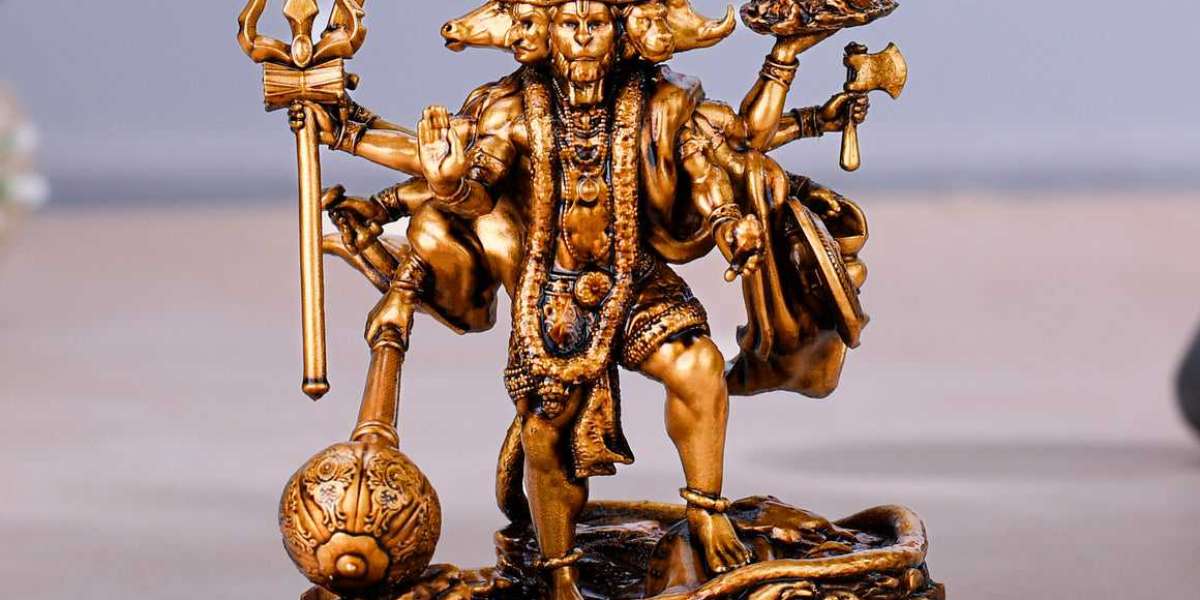The Spiritual Significance of Panchmukhi Hanuman
Hanuman, a central figure in Hindu mythology, is celebrated for his unwavering devotion to Lord Rama, his immense strength, and his role as a protector of dharma. The Panchmukhi Hanuman statue is particularly unique due to its depiction of Hanuman with five faces, each representing a different aspect of his divine nature:
Hanuman (East-facing): This face portrays Hanuman in his most revered form, symbolizing courage, loyalty, and devotion to Lord Rama. It represents the core attributes of Hanuman, including his dedication and selfless service.
Narasimha (South-facing): Narasimha, the lion-headed avatar of Vishnu, represents divine protection and the destruction of evil. This face symbolizes Hanuman’s role in safeguarding dharma and combating malevolent forces.
Garuda (West-facing): The eagle-headed face of Garuda, the vehicle of Vishnu, embodies strength and the ability to overcome obstacles. It signifies the power and resilience that Hanuman possesses in his divine capacity.
Varaha (North-facing): Varaha, the boar-headed incarnation of Vishnu, symbolizes the restoration of righteousness and the protection of the Earth. This face reflects Hanuman’s role in upholding justice and maintaining cosmic order.
Hayagriva (Skyward-facing): Hayagriva, the horse-headed avatar of Vishnu, represents wisdom and knowledge. This face highlights Hanuman’s role in preserving sacred teachings and imparting wisdom to his devotees.
The combination of these five faces creates a comprehensive representation of Hanuman’s divine attributes and his role as a universal protector.
The Vision and Execution
The vision to construct the world’s tallest Panchmukhi Hanuman statue was conceived by the trustees of the Paritala Anjaneya Swamy Temple. Their objective was to create a grand monument that would inspire and uplift people, while also attracting spiritual tourism to the region. The project was designed to merge spiritual significance with architectural grandeur, making it a symbol of devotion and artistic achievement.
Realizing this vision required meticulous planning and innovative engineering. The construction involved collaboration among architects, engineers, and artisans to ensure that the statue met both spiritual and structural requirements. The result is a statue that stands as a testament to human ingenuity and devotion.
Architectural Marvel
The Panchmukhi Hanuman statue is an architectural marvel that combines traditional artistry with modern engineering techniques. The statue is set upon an elaborate pedestal that enhances its grandeur and visual impact. Made primarily of reinforced concrete, the statue is designed to withstand environmental conditions and ensure long-term durability.
The exterior of the statue is coated with a specialized bronze alloy, giving it a majestic appearance while protecting it from the elements. The design adheres to Vastu Shastra, an ancient Indian science of architecture that ensures the structure radiates positive energy and harmony.
Advanced technologies, including 3D modeling and computer-aided design, were used to achieve the intricate details and precise proportions of the statue. The combination of traditional craftsmanship and modern engineering has resulted in a monument that is both awe-inspiring and enduring.
Overcoming Construction Challenges
Constructing the world’s tallest Panchmukhi Hanuman statue presented several significant challenges. The project required overcoming logistical, technical, and environmental obstacles. One of the primary challenges was ensuring the structural stability of the statue given its immense height and weight.
Engineers used a combination of reinforced concrete and steel to create a strong and stable framework capable of withstanding seismic activity and environmental stresses. The foundation was meticulously designed to support the massive structure and ensure its longevity.
The construction process also involved managing large-scale logistics, including the transportation of materials and coordination of manpower. Adverse weather conditions and technical difficulties were addressed through effective project management and problem-solving strategies.
Spiritual and Cultural Impact
Since its inauguration, the Panchmukhi Hanuman statue has become a major center of spiritual and cultural significance. It attracts thousands of devotees and tourists who come to seek blessings, meditate, and experience the divine presence of Hanuman. The site has been developed with comprehensive facilities, including meditation halls, prayer rooms, and a museum dedicated to the life and teachings of Hanuman.
The statue also serves as a hub for cultural events and festivals that celebrate Indian heritage and spirituality. These events draw large crowds and foster a sense of community, enhancing the cultural vibrancy of the region.
Economic and Tourism Benefits
The statue has significantly boosted tourism in Vijayawada, transforming it into a prominent destination for spiritual and cultural tourism. The influx of visitors has created numerous opportunities for local businesses, including hotels, restaurants, and shops. The increased tourism has led to economic growth in the area, providing employment opportunities and stimulating infrastructure development.
The statue’s presence has also enhanced the region’s profile on the global stage, attracting attention from international tourists and media. This has further contributed to the area’s economic development and cultural exchange.
Preservation and Legacy
Preserving the Panchmukhi Hanuman statue is crucial to maintaining its status as a symbol of faith and inspiration. Ongoing conservation efforts are in place to protect the statue from environmental damage and ensure its long-term preservation. Regular maintenance work is conducted to address issues related to wear and tear.
Educational programs and workshops are organized to promote awareness about the cultural and spiritual significance of Hanuman. These initiatives aim to educate future generations about India’s rich heritage and the teachings of Hanuman, ensuring that his legacy endures for years to come.
Conclusion
The world’s tallest Panchmukhi Hanuman statue stands as a remarkable achievement in both engineering and spiritual symbolism. Its towering height and intricate design make it a landmark of faith and devotion, showcasing the divine attributes of Hanuman and the excellence of Indian craftsmanship.
As a beacon of hope and inspiration, the statue continues to attract people from all walks of life. It represents the enduring legacy of Hanuman’s virtues and serves as a powerful reminder of the values of strength, loyalty, and protection. The statue enriches the spiritual and cultural landscape of India and stands as a testament to the extraordinary achievements of modern engineering and traditional artistry.








